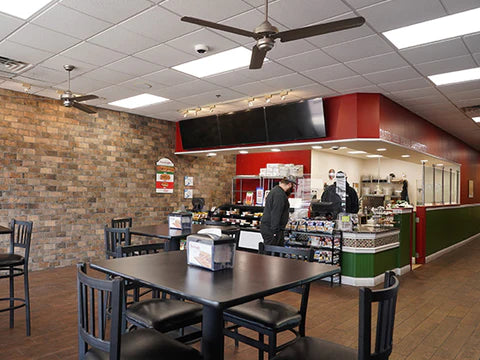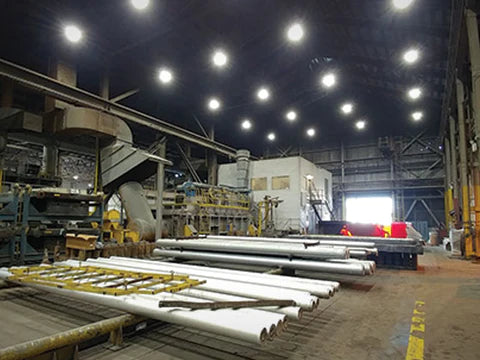How to Save Money on Electricity at Your Business
Reducing energy costs is a priority for many businesses, as it not only helps save money but also contributes to a more sustainable and eco-friendly operation.
Commercial buildings consume a large amount of energy. And, on average, depending on building size, hours of operation, and type of business, lighting alone accounts for 20–50% of energy expenditure.
Businesses can't do without lighting, however. Bright, dependable lighting is needed for security outside the building and safety outside and within. Lighting is needed for employee productivity, as well as for visitor experience. You can't shut off your lights to reduce your operating costs—but you can switch to much more efficient lighting.
Shop Now for High-Efficiency LightingBut you came here to save money, not spend it. Hold on, though: it could cost significantly less than you think to change your business's lights.
In fact, in some areas of the country, companies have been able to switch over to LED lighting for not much more than their regular annual lighting maintenance expenditure. As a side benefit, that annual lighting maintenance expenditure drops considerably, too, once LED lighting is in place.
Let's look at the big advantages of LED lighting—then we'll get to how you can reduce the cost of making the switch.
How LED Lighting Earns Its Keep
Lower Energy Consumption
LED lights are highly energy-efficient, consuming up to 80% less energy compared to traditional lighting. With lighting making up 20% to 50% of the average commercial building's energy expenditure, switching to LED lights can make a tangible impact on your energy bills.
Long Lifespan
LED lights have an average operating life of 50,000 hours or more while traditional lighting, depending on the technology, ranges from 2,000 to 25,000 hours. This extended operating life of LED lights eliminates the need for frequent re-lamping, and all the labor and material costs associated with that task.
Improved Performance
LED lights have a high color rendering index (CRI), which means that they provide more accurate and vibrant colors, particularly compared to fluorescent lighting. This improved color rendering can enhance the work environment, reducing the need for additional light sources, such as task lighting. This further reduces energy consumption.
Increased Control and Flexibility
LED lights can be controlled and dimmed using advanced lighting control systems. Whether you install simple occupancy or photovoltaic sensors or invest in a property-wide smart controls system, your lights will run even more efficiently, further reducing your energy bill. Plus, your employees and visitors benefit from a more comfortable and visually appealing environment.
How to Make the Switch without Breaking the Bank
You may be thinking, while the benefits above are all well and good, you don't have the money for fancy new lights. You're trying to save money, not spend it.
But, there are ways to make this changeover affordable, so that you can then benefit from energy savings that puts money back into the business year after year. We've had customers able to get their upgrade investment down to as low as their annual spend on lighting maintenance. Here's how they whittled that investment down:
Let Your Utility Provider Cover Some of the Cost
Many utilities offer energy efficiency incentives to encourage their commercial customers to upgrade their systems—lighting included—to more efficient models. Incentives programs differ in availability and amounts across the country. Some utilities don't offer funds; others will cover nearly the entire cost of the new lighting. It's absolutely worth checking what energy efficiency incentives are available to your business.
Leverage Tax Incentives to Your Benefit
The Inflation Reduction Act of 2022 expanded the projects that qualify for the Commercial Buildings Tax Deduction (Section 179D of the tax code). This incentive takes the form of an accelerated tax deduction, meaning the entire deduction can be taken in a single year, giving your company faster payback for the upgrades. The deduction applies to, among other things, upgrades to interior lighting systems that reduce total energy and power costs for lighting by 25% or more.* This deduction starts at $0.50 per square foot. For a 10,000 square foot building, that's $5,000 right there. The bigger the energy reduction, the higher the square foot rate is, and the deduction can go as high as $5.00 per square foot if prevailing wage and apprenticeship requirements are met. We recommend you check with your accountant to see how much you could qualify for if you upgrade your building's lighting.
Get Lower Prices by Taking a Bigger Plunge
In business, we're all familiar with quantity discounts. You can get a much better price on replacement lamps or light fixtures when you buy a pallet of them at once, versus buying them one and two at a time. So, rather than taking the path of "upgrading each light as it burns out," leverage all available discounts:
- Buy enough lights at a time to trigger better pricing. ELEDLights makes getting price breaks easy—click the "Request Bulk Quote" link on any light's page on our website. If you're not sure if it's better to do part or all of your building, ask for quotes on both quantities.
- Ask if your lighting supplier offers discounts for paying by check and/or using your own shipping account. ELEDLights can take 2% off your order if you pay by check or money order payments, and 5% off if you use your own shipping account. Just call us at 215-355-7200 to arrange it.
- You'll also save by hiring an electrician for one big job once rather than many small jobs over time. It's also less of a disruption to your business.
Not only do you save money by upgrading all your lights at once, you also ensure consistent lighting quality and avoid discrepancies in brightness and color temperature that can occur when lights are replaced at different times.
In conclusion, LED lights play a critical role in maximizing energy efficiency in commercial buildings. Their benefits, including lower energy consumption, long lifespan, reduced maintenance requirements, improved performance, and increased control and flexibility easily pay back the investment in LED lighting. By making the switch to LED lights, commercial buildings can reduce energy costs, improve the work environment, and achieve sustainability goals.
* Compared to a reference building that meets the minimum requirements according to Reference Standard 90.1 in Section 179D(c)(2). See Title 26 U.S. Code § 179D - Energy efficient commercial buildings deduction.

 215.355.7200
215.355.7200




